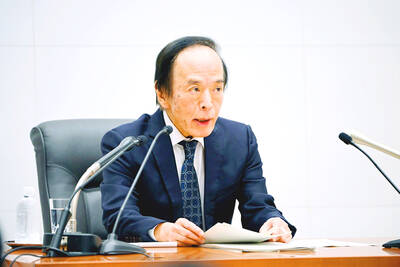Applied Materials Inc, the largest US maker of chip-manufacturing equipment, on Thursday gave a lukewarm revenue forecast for the current period, citing the risk of export controls crimping its business.
Sales would be about US$7.1 billion in the fiscal second quarter, which runs through April, the company said in a statement.
That compares with an average Wall Street estimate of US$7.22 billion.

Photo: Reuters
Profit per shares would be US$2.30, Applied Materials said, in line with projections.
Applied Materials chief financial officer Brice Hill said the company was “taking into account export control related headwinds.”
China makes up about one-third of the company’s sales and stricter trade curbs from the US have made it harder to sell in that nation.
The company’s shares fell about 5 percent in extended trading following the announcement. They had earlier closed at US$184.27, up 13 percent this year.
Export rules adopted in the final months of the administration of former US president Joe Biden would knock about US$400 million off revenue this fiscal year, the company said.
About half of the reduction would come in the current period, with much of it hitting Applied Materials’ service business.
That is because the company would have to stop servicing equipment at some customer sites in China, Applied Materials chief executive officer Gary Dickerson said on a conference call with analysts.
In the long term, Dickerson said he expects the company’s service operations to resume healthy growth.
China accounted for 31 percent of sales last quarter, down from 45 percent a year earlier.
A surge in orders from Chinese memorychip makers has not continued into this year, the company said.
Meanwhile, Applied Materials is enjoying high demand for the most advanced types of equipment needed for artificial intelligence (AI) components, Dickerson said.
That is making up for weaker demand from makers of less complicated chips, he said.
“The biggest driver for the whole industry is AI,” he said.
The amount of silicon going into data centers — facilities that handle much of the AI workload — will soon surpass the level consumed by personal computers and smartphones.
Those have traditionally been the two biggest markets for chipmakers.
First-quarter profit was US$2.38 per share, excluding some items, compared with an estimate of US$2.28. Revenue gained 6.8 percent to US$7.17 billion. Analysts projected US$7.15 billion.
The company is facing tax changes in Singapore, resulting in an expense of US$644 million, or US$0.79 per share during this fiscal year.
Applied Materials’ management has maintained confidence in the overall growth of the industry.
The rapid spread of semiconductors to new products and the AI boom would help maintain demand, Dickerson said.
The sheer complexity of chips has also added pressure on customers to upgrade their equipment, he said.
Customers of Applied Materials include some of the biggest names in the chip industry, including Taiwan Semiconductor Manufacturing Co (台積電), Samsung Electronics Co and Intel Corp. Those manufacturers order gear well ahead of starting production, making Applied Materials’ forecasts a barometer for demand.

Taiwan Semiconductor Manufacturing Co (TSMC, 台積電) last week recorded an increase in the number of shareholders to the highest in almost eight months, despite its share price falling 3.38 percent from the previous week, Taiwan Stock Exchange data released on Saturday showed. As of Friday, TSMC had 1.88 million shareholders, the most since the week of April 25 and an increase of 31,870 from the previous week, the data showed. The number of shareholders jumped despite a drop of NT$50 (US$1.59), or 3.38 percent, in TSMC’s share price from a week earlier to NT$1,430, as investors took profits from their earlier gains

In a high-security Shenzhen laboratory, Chinese scientists have built what Washington has spent years trying to prevent: a prototype of a machine capable of producing the cutting-edge semiconductor chips that power artificial intelligence (AI), smartphones and weapons central to Western military dominance, Reuters has learned. Completed early this year and undergoing testing, the prototype fills nearly an entire factory floor. It was built by a team of former engineers from Dutch semiconductor giant ASML who reverse-engineered the company’s extreme ultraviolet lithography (EUV) machines, according to two people with knowledge of the project. EUV machines sit at the heart of a technological Cold

TAIWAN VALUE CHAIN: Foxtron is to fully own Luxgen following the transaction and it plans to launch a new electric model, the Foxtron Bria, in Taiwan next year Yulon Motor Co (裕隆汽車) yesterday said that its board of directors approved the disposal of its electric vehicle (EV) unit, Luxgen Motor Co (納智捷汽車), to Foxtron Vehicle Technologies Co (鴻華先進) for NT$787.6 million (US$24.98 million). Foxtron, a half-half joint venture between Yulon affiliate Hua-Chuang Automobile Information Technical Center Co (華創車電) and Hon Hai Precision Industry Co (鴻海精密), expects to wrap up the deal in the first quarter of next year. Foxtron would fully own Luxgen following the transaction, including five car distributing companies, outlets and all employees. The deal is subject to the approval of the Fair Trade Commission, Foxtron said. “Foxtron will be

INFLATION CONSIDERATION: The BOJ governor said that it would ‘keep making appropriate decisions’ and would adjust depending on the economy and prices The Bank of Japan (BOJ) yesterday raised its benchmark interest rate to the highest in 30 years and said more increases are in the pipeline if conditions allow, in a sign of growing conviction that it can attain the stable inflation target it has pursued for more than a decade. Bank of Japan Governor Kazuo Ueda’s policy board increased the rate by 0.2 percentage points to 0.75 percent, in a unanimous decision, the bank said in a statement. The central bank cited the rising likelihood of its economic outlook being realized. The rate change was expected by all 50 economists surveyed by Bloomberg. The